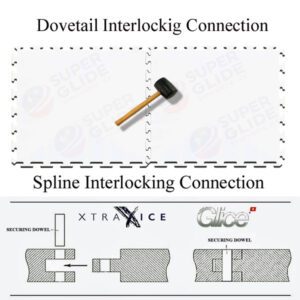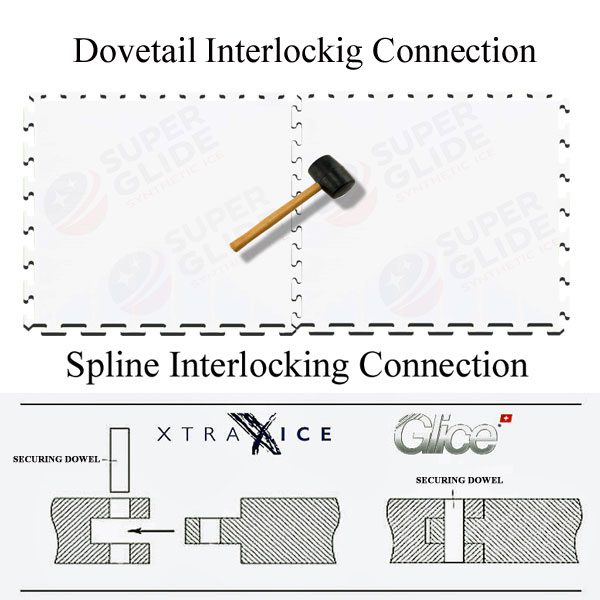
Choosing the most slippery synthetic ice with a reliable, seamless installation comes down to evaluating several important factors. Here are some key considerations.
Material.
Synthetic ice is typically made from a high-density polyethylene or ultra-high molecular weight polyethylene. These plastic materials are durable, providing a slick surface for skating. Look for companies that use high-quality materials in their synthetic ice products.
Infused Glide Technology.
Some synthetic ice panels have self-lubricating properties that create a more slippery surface. This is done through a process called infused glide technology, where glide-enhancing additives are integrated into the material during production. Panels with this technology require less maintenance and perform more like real ice.

Seamless Connections.
For a seamless installation, you want to look at the way the panels connect. Currently, the most popular interlocking techniques are Dovetail and Spline.
Dovetail Installation Technique.
The dovetail method involves interlocking the synthetic ice panels at an angle, creating a tight and secure fit. The panels are cut with angled edges, resembling a dovetail joint, which allows them to interlock smoothly. This technique provides excellent stability and helps minimize any shifting or separation between the panels during use.
Pros of Dovetail Installation:
– Strong interlocking mechanism, ensuring a secure fit between panels.
– Reduced chance of separation or shifting during intense use.
– Creates a seamless appearance with minimal visible gaps between panels.
Cons of Dovetail Installation:
– Requires precise cutting and fitting of the panels to achieve the dovetail shape.
– May require additional effort during installation due to the angled cuts.
Spline Installation Technique.
The spline method involves using a flexible plastic spline that fits into grooves on the edges of the synthetic ice panels. The spline acts as a connector, holding the panels together while allowing for some flexibility. This technique is relatively quick and straightforward, making it popular for temporary or portable installations.

Pros of Spline Installation:
– Easy and efficient installation process, especially for temporary or portable setups.
– Panels can be disassembled and reassembled with relative ease.
– Provides some flexibility, allowing for slight expansion and contraction of the panels.
Cons of Spline Installation:
– Slightly less stability compared to the dovetail method, especially during intense use.
– Visible gaps may be more noticeable between the panels due to the flexible nature of the spline.
– May require periodic tightening or adjustment of the spline over time.
Both dovetail and spline techniques have their advantages and considerations. The choice between the two methods depends on factors such as the intended use of the synthetic ice rink, budget, installation timeline, and preferences regarding aesthetics and long-term stability. It’s recommended to consult with synthetic ice manufacturers or installation professionals who can provide guidance based on your specific requirements and goals.
Maintenance Requirements.
Consider the maintenance requirements of the synthetic ice solution. Look for panels that are easy to clean and require minimal upkeep. Some synthetic ice options may need periodic lubrication to maintain optimal glide.
Price and Value.
Synthetic ice solutions come at different price points. Consider your budget and compare prices from various suppliers. However, don’t compromise on quality for the sake of saving money. Look for a solution that offers good value for your investment.
Brand Reputation.
Before buying synthetic ice, research the manufacturer’s reputation. Read reviews, consult professional testimonials, and if possible, try out their product. Well-established brands often provide high-quality products and better customer service.

Installation Services.
Some companies offer installation services, ensuring that their product is properly set up for best performance. If you’re not experienced in installing synthetic ice, this can be a major benefit.
Warranty and Support.
Check the warranty offered by the manufacturer or supplier. A reliable warranty demonstrates the confidence they have in their product. Additionally, assess the quality of customer support provided by the company to ensure assistance is readily available if needed.
By considering these factors, you can choose a synthetic ice solution that meets your requirements and provides an enjoyable skating experience. Whether you’re setting up a training facility or creating a personal skating space at home, synthetic ice can be a fantastic alternative to traditional ice rinks.

